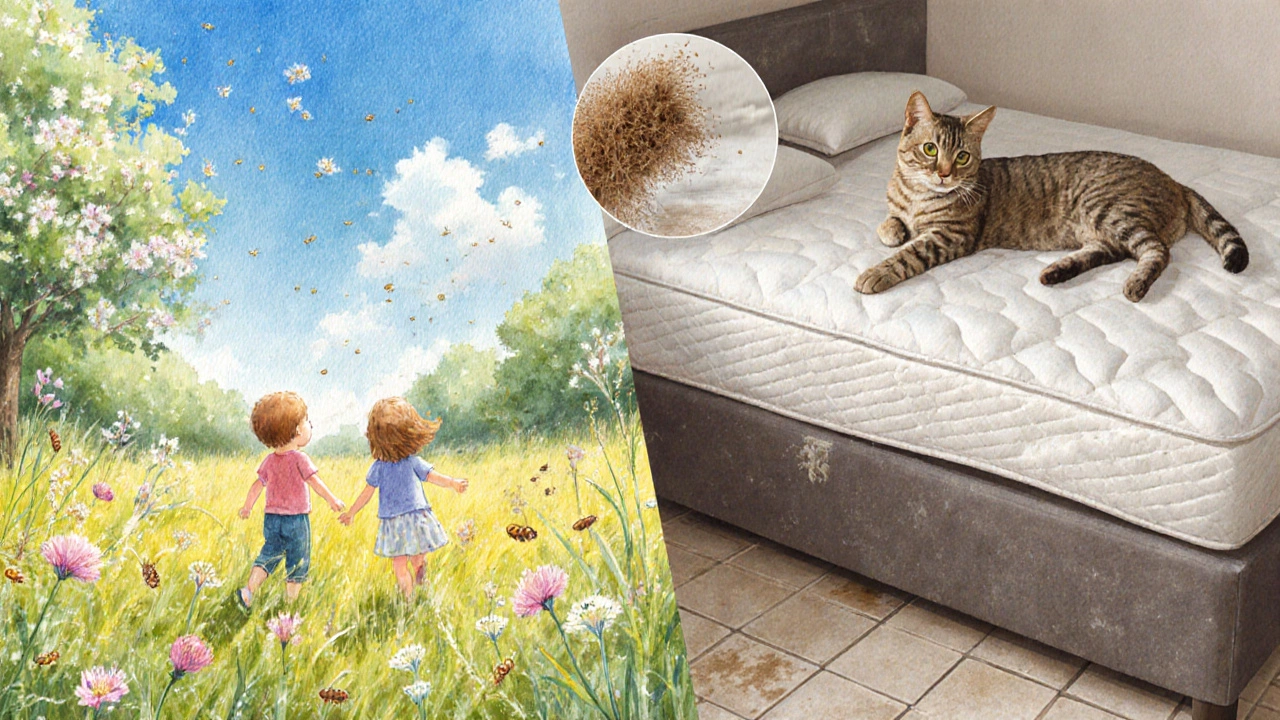Allergy Awareness Quiz
Seasonal Allergies
Triggered by outdoor allergens like tree, grass, and weed pollens.
Perennial Allergies
Caused by allergens present year-round like dust mites and pet dander.
Allergies don’t take a vacation, yet many people only think about them when pollen clouds roll in or when a cold snap stirs up mold spores. That mindset leaves us vulnerable to flare‑ups during the quiet months, and it makes it harder for schools, workplaces, and healthcare providers to plan proper support. allergy awareness all year long can cut emergency visits, improve quality of life, and keep communities informed about emerging triggers.
Quick Takeaways
- Allergy symptoms can appear any month; understanding triggers year‑round reduces missed work or school.
- Seasonal and perennial allergies differ in timing, common allergens, and management strategies.
- Tracking pollen counts and indoor air quality helps you act before symptoms start.
- Education tools - from CDC fact sheets to smartphone apps - keep you prepared for unexpected flare‑ups.
- Advocating for allergy‑friendly policies at home, work, and school creates safer environments for everyone.
What Is Allergy Awareness?
Allergy awareness is the collective knowledge about what triggers allergic reactions, how they manifest, and what steps can be taken to prevent or treat them. It goes beyond a simple list of pollen types; it includes understanding immune system responses, recognizing high‑risk periods, and knowing where to find reliable information.
Why Year‑Round Matters
Typical public health messages spike in spring and fall, coinciding with classic pollen seasons. However, data from the Centers for Disease Control and Prevention show that emergency department visits for allergic reactions climb in winter too, driven by indoor allergens like dust mites, pet dander, and mold from heating systems.
Climate change adds another layer of complexity. Longer growing seasons mean higher cumulative pollen exposure, while warmer winters allow mold to thrive indoors. The result? People who thought they’d be “allergy‑free” during winter now experience sneezing, wheezing, and eye irritation.
Year‑round vigilance also supports people with perennial allergies. These individuals react to allergens present year‑long - think dust mites, cockroach droppings, or indoor molds - and need consistent strategies, not just a seasonal checklist.
Types of Allergies: Seasonal vs. Perennial
Understanding the two major categories helps you tailor prevention and treatment.
| Aspect | Seasonal Allergies | Perennial Allergies |
|---|---|---|
| Common Triggers | Pollen from trees, grasses, weeds | Dust mites, pet dander, indoor mold, cockroach allergens |
| Typical Season | Spring (tree pollen), early summer (grass), fall (weed) | All year, intensifies during humid months |
| Symptoms | Sneezing, itchy eyes, runny nose, throat irritation | Chronic congestion, cough, wheezing, skin rashes |
| Management Tips | Stay indoors during high pollen counts, use antihistamines, rinse sinuses | Use HEPA filters, wash bedding weekly in hot water, control indoor humidity |

Staying Educated All Year
Consistent education starts with reliable sources. The CDC publishes an annual Allergy and Asthma Data Portal that breaks down national trends, regional hotspots, and emerging allergens. Subscribe to their free email updates for the latest statistics.
Technology makes tracking easy. Smartphone apps such as Pollen.com or AIRNow give real‑time pollen counts and Air Quality Index data. Set alerts for your zip code and plan outdoor activities when counts dip below the “moderate” threshold.
For deeper learning, consider accredited online courses from organizations like the American College of Allergy, Asthma & Immunology (ACAAI). Their free webinars cover topics ranging from immunotherapy basics to managing food allergies in schools.
Practical Steps for Individuals
- Know Your Triggers - Keep a symptom diary for at least two weeks. Note date, location, weather, and any new products you used.
- Control the Environment - Use HEPA air purifiers in bedrooms, wash curtains monthly, and vacuum with a cartridge filter.
- Medication Ready - Keep non‑prescription antihistamines, nasal steroids, and eye drops accessible. Discuss prescription options like leukotriene modifiers with a clinician.
- Consider Immunotherapy - For persistent seasonal allergies, sublingual tablets or allergy shots can desensitize the immune system over 3-5 years.
- Stay Hydrated and Healthy - Adequate water thins mucus, while regular exercise improves lung capacity, reducing the impact of allergic asthma.
Community and Advocacy
Allergy education isn’t just personal; it spreads through families, schools, and workplaces. Here’s how to champion it:
- Schools - Request that administrators adopt an Allergy Action Plan for each student. Provide teachers with symptom‑recognition handouts.
- Workplaces - Encourage HR to stock basic allergy medication in first‑aid kits and to allow flexible work‑from‑home days during peak pollen spikes.
- Public Spaces - Advocate for outdoor event planners to monitor pollen forecasts and to post real‑time alerts on venue websites.
When communities understand that allergies affect productivity and healthcare costs, they’re more likely to invest in air‑filtration upgrades and educational workshops.
Common Myths and Pitfalls
Myth 1: "I only get allergies in spring, so I can ignore them in winter." Reality - Perennial allergens can cause chronic symptoms that worsen when heating systems circulate dust.
Myth 2: "Natural remedies cure allergies." While saline rinses and honey may soothe, they don’t address the immune response; stopping proven medications can lead to severe flare‑ups.
Pitfall: Relying on a single data source. Pollen counts can vary between agencies. Cross‑check at least two reputable platforms before making health‑related decisions.
Frequently Asked Questions
Do I need allergy medication year‑round?
If you have perennial allergies or a history of severe seasonal reactions, doctors often prescribe a low‑dose antihistamine or nasal steroid to use daily. This keeps inflammation low and reduces the chance of sudden attacks.
How accurate are pollen count forecasts?
Most forecasts are generated from a network of aerobiology stations and have a reliability of about 80% for 24‑hour predictions. Accuracy improves when you combine multiple sources and consider local weather patterns.
Can indoor air purifiers really help with allergies?
HEPA filters capture particles down to 0.3µm, which includes most pollen, dust mite feces, and pet dander. Studies published in the Journal of Allergy and Clinical Immunology show a 30‑40% reduction in symptom scores when a purifier runs continuously in the bedroom.
Is allergy immunotherapy safe for children?
Yes. Clinical trials involving over 5,000 children have shown that sublingual tablets are well‑tolerated, with the most common side effect being mild mouth irritation. Long‑term benefits include reduced medication use and lower asthma risk.
What should I do if a coworker has a severe allergic reaction?
Call emergency services immediately. If the person carries an epinephrine auto‑injector, administer it according to the label. Keep a calm environment, note the trigger if known, and inform workplace health and safety officers.

Comments (9)